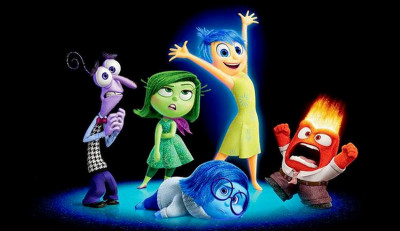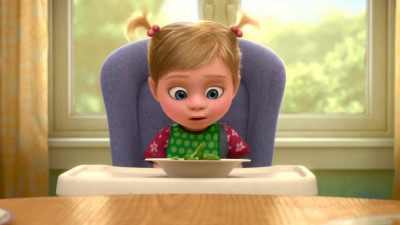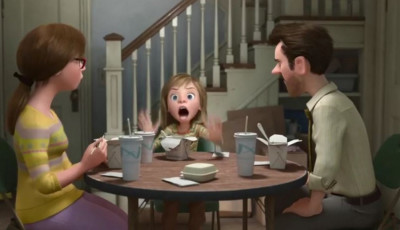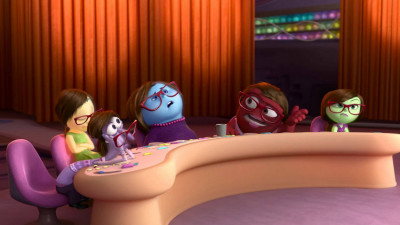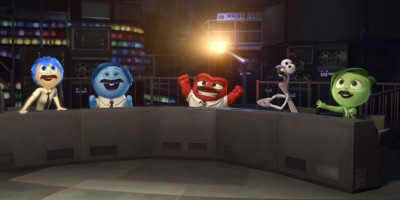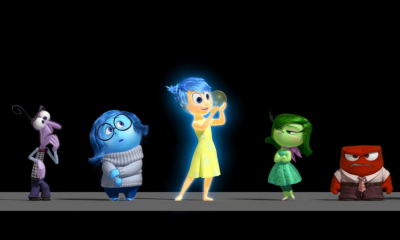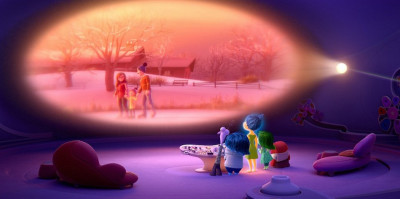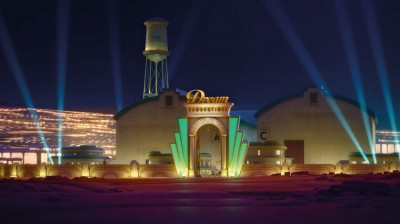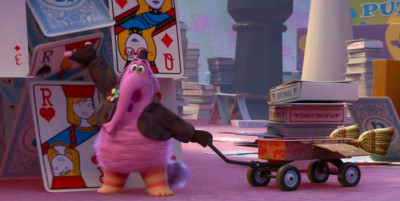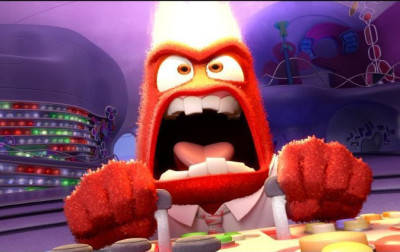Pixar Animation Studios has done it again. Not only have they delivered what should prove to be the indisputable Academy Award winner for Best Animated Feature come February 28, 2016, but a hot contender as an overall Best Picture nominee with ‘Inside Out’. Breaking new ground with storytelling and technology, while retaining the hallmarks of what makes Pixar great, director Pete Docter and the Pixar team boldly go where no one has gone before – inside the mind of an 11-year old girl. To say that ‘Inside Out’ will turn you upside down and inside out with utter and complete “joy” and wonder is an understatement. One look and it fills you with all the happiness of the colors of the rainbow, sprinkled with stardust from above, welcoming you into the emotion-filled world of Riley.
LISTEN NOW: Bill Hader explains what makes INSIDE OUT an “Essential”
We first meet Riley on the day she is born. Filled with joy and gleeful baby happiness (at least that’s what her primary emotion Joy tells us), we watch Riley grow with joy and happiness. Yes. Joy. In the world of ‘Inside Out’ there are five main emotions with Joy being the alpha group leader – Joy, Sadness, Fear, Anger and Disgust – and Joy serves as a tour guide, so to speak. She helms the neurological command center in Riley’s brain. Each plays an integral part to our development. Joy makes us happy. Fear keeps us safe. Anger helps with social skills and attention getting. Disgust keeps us away from icky things like broccoli and brussel sprouts. And Sadness, well, where there is Joy, there has to be Sadness as Sadness leads to so many other wonderful things in life. Each spends their days pulling levers and pressing buttons on the HQ control panel guiding Riley through her day (of course, Joy is always the one who wins out with command). You’ll see. We see wonderful core memories of happiness being made and thanks to Joy and company, learn the inner workings of the mind and how memories are stored, recalled or discarded. Pretty intricate stuff going on in there; even moreso with an 11-year old girl. (Don’t feel slighted Mom and Dad! We get to see your HQ workings as well!)
But then the emotions suffer a jarring experience. Riley is forced to move from her home in Minnesota to San Francisco, saying goodbye to her room, her ice hockey team, her friends, open spaces, all the good memories of her life. And from the start (like with broccoli pizza), San Francisco goes from bad to worse with Joy working overtime trying to get “our girl” back on track in the happiness department, only to be thwarted at every turn by all the other emotions. Riley argues with her parents at the dinner table, gives Dad an attitude, cries at school, has a disastrous ice hockey tryout. And all this AFTER the moving van is over a week late with all those little treasures that might make Riley feel more at home. Seems like Sadness reigns supreme right about now. And it does; much to Joy’s chagrin.
Believing Sadness to be the cause of Riley’s sudden change of disposition, Joy orders Sadness to not touch any of the bright yellow glowing balls that represent the happy core memories; you know, those memories that always make you smile inside and out, the ones you think of when you need a pick me up. But something weird is happening. Everytime Sadness touches a core memory, it turns it blue, taking it from a happy memory to a sad memory. Oh, what’s that? The core memory glowy balls? Each is a memory that is color correspondent to the emotion Riley felt at the moment the memory is made. Then, thanks to the elaborate storage system within the mind, memories are shuffled, filed, stored or even discarded in a glorious array of pinball pinging delights. It’s important to note that the core memories, the purest of pure memories which comprise what are known as “emotional islands”, make up who each of us is. In Riley’s case – Fun Island, Hockey Island, Family Island, Honesty Island and Friendship Island – and we need a balance of memories to keep each island going.
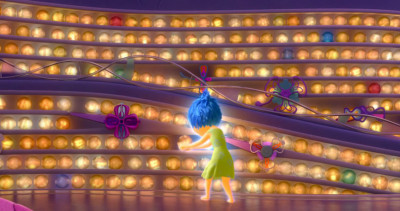
But then disaster strikes! Trying to save the core happy memories which Sadness has inadvertently let loose all over HQ, Joy and Sadness are sucked up into the vacuum that whisks memories to their respective places at the end of the day!! (You didn’t think just because the day ends and Riley’s eyes closed for sleep that the work ended in HQ! Oh no! There’s much going on when the lights are out.) But with Joy and Sadness gone from HQ, that means Fear, Anger and Disgust are left in charge and the only memories that Riley can have or make. Uh, oh.
In what is one of the most endearing “buddy comedy” pairings ever, Joy and Sadness try to make their way back to HQ, while Fear, Disgust and Anger run amok. The result is that we are treated to the most imaginative inner workings of the mind ever seen, as abstract concepts and consciousness are explored with eye-popping animation. We reconnect with our own imaginary friends as the purity and joy of childhood bubble forth, we learn phobias aren’t so fearful and dreams can be the coolest things ever. But will Riley ever reconnect with hers, especially after her emotional islands crumble.

Directed by Pete Docter and written by Docter together with Meg LeFauve and Josh Cooley, based on an original story inspired by Docter watching his own daughter grow up, the writing is intelligent and clever, filled with witticisms and tongue-in-cheek double entendres. Most impressive is the research conducted by Docter, delving deep into neurologic and psychologic studies and treatises with experts in the fields to learn about emotions and intricate brain patterning. It is from this research that the emotions and the various compartments and neuron networks of the brain are based, all of which are then designed with jaw-dropping, imaginative animation. Combining story and visuals, there are more than enough elements of wackiness to keep a perpetual smile on your face while at the same time really serving as elementary explanation of how the mind works. The individual emotions are extremely well crafted and identifiable, thanks not only to the depth of the characters but the animation and voice casting.
EXCLUSIVE: Producer Jonas Rivera on the “equitability of emotions”
Amy Poehler brings her patented upbeat “can do” attitude to Joy, while Phyllis Smith embodies the “woe is me” of Sadness. Bill Hader makes timid hysteria more frenetic than ever with his take on Fear while Mindy Kaling is perfection as Disgust. (That’s “Disgust”. Not “Disgusted”.) The real gem, however, is found with the perfect casting of Lewis Black who is the very embodiment of Anger. No one could play Anger but for Black. But the character and voicing that steals the heart and opens the tear-filled flood gates of the audience’s emotion is Richard Kind as Riley’s imaginary friend, Bing Bong. Now is the time to add a best voice casting Academy Award because it definitely would go to Kind. A poignantly touching turning point in the film and for Riley, Bing Bong will steal your heart and bring a tear (okay, a flood) to your eyes.
Notable is the equitability of emotions. Everybody, each emotion, is essentially on equal playing fields in terms of the time allotment within the film. They may not always be front and center visually, but then they are worked into the dialogue. All the emotions are getting their fair share here. According to producer Jonas Rivera, “Our editor Kevin Nolting deserves a lot of credit because he really made sure that the film was load balanced, not only narratively, but in terms of the entertainment value and who said what. . .They’re all on one level, one note and funny, but we hope on another level they’re all in service of Riley. And if you care about Riley, you care about them doing a good job, because they do.”
EXCLUSIVE: Producer Jonas Rivera talks editing emotional levels
Animation is king with ‘Inside Out’, particularly the use of color and the creation of the individual emotions. With a glittering etherealness to each of the emotions, there is a velour texture to the characters with an almost fairy dust, glistening or bubbling off like little champagne bubbles that is stunning. And color is everything . For Docter, “[W]e knew we wanted it to be a broad, comedic caricatured world inside HQ’s head. So we designed the characters very stylized and pushed, and then we chose primary colors really opposite each other so that everybody occupies their own space in the color spectrum. Some of them were obvious – Anger obviously red is kind of iconic. Purple for Fear was a little more like, ‘Well, we haven’t used that color, so that’ll be purples.’”
LISTEN NOW: Pete Docter and Jonas Rivera talk about color and technical design of INSIDE OUT
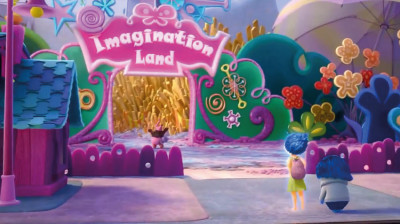
But then there are the particles and the sparkling. Wanting the emotions to look the way they feel, Docter “knew we didn’t want them to look like flesh or cloth or whatever. We wanted it to be something unique and different. . .The animators worked with a solid character the way we usually do and then that’s replaced by a fog and in with the fog are all these frontward facing dots that just kind of roil and move so no matter where the camera goes, they orient to face the camera because they’re flat discs. Between those things, plus a bit of glow and quite a bit of jiggery pokery to get the glowing, especially on Joy, to work, [we have the emotions].”
A real technical advancement is with the lighting and having a character that is a light source, as Joy is. As Docter points out, “[T]here’s only two shots in the film that she has a shadow. All the rest – because you put a light on the table and it wouldn’t cast a shadow, it would cast a light onto the surface – we reversed that out.” Enabling this unique lighting is a process called Geometry Light Technology and Globe Illumination. While Globe Illumination has been used in less advanced stages by Pixar artisans in earlier films, Geometry Light is a new and exciting technology that could garner some science and technical Oscar attention. Expounding on the process, Rivera notes, “It sort of allows light to behave like light in the real world. It knows where practical lights are and it casts shadows and does a lot of the work for you, which is great, until you come up with a movie where you’re completely asking your technical team to break the rules about how light behaves. There’s no shadows. . . I think [the technical team] were really excited about the challenge of having something very literal. Pete would come and say, ‘I want it to feel this way or it should look like emotions feel.’ It’s this very interpretive thing and very technical which we thought was cool and came up with something that looks unique and different.” Personally, Rivera’s hope is “I want the audience to do is go, ‘Oh My Gosh! This looks unlike anything I’ve ever seen. It doesn’t look like anything that they’ve done.’” Trust me. It doesn’t and the result is jaw-droppingly lush and beautiful.
EXCLUSIVE: Producer Jonas Rivera talks “Geometry Light Technology”
Hand in hand with the technical achievements and animation is the production design of Ralph Eggleston who readily admits he was influenced by the greats from the Golden Age of Hollywood and the elements of Technicolor. Filling the mind’s eye with everything imaginable from movie studios to trains to clowns to pinball machines to quiet whistful images and hilarious imaginative Daliesque sequences, Eggleston’s own imagination worked overtime here. One of Eggleston’s showcases is “Dream Productions” which pays loving homage to that Golden Age and the movie machines of MGM, Paramount and more. Look for an Oscar nomination to come Eggleston’s way for his work here.
The icing on the cake is Michael Giacchino’s score which captures all the emotions of the rainbow, and never moreso than in a powerful and emotional sequence involving Joy and Bing Bong. The music is as touching and poignant as the unfolding scene.
Perhaps Bill Hader sums up the true essence and spirit of “Inside Out” the best. “I think what’s so great about this movie is that they chose to make a film about a time in your life that we all have to go through. When you’re young, you’re good to go. Then you’re an adolescent and things start to change and it’s hard for you. And a lot of movies about normal people don’t talk about that. . .You look for answers and you think you’re the only one going through this thing and this film – they did it in such a beautiful, fantastical way. That’s why you have to see it.”
A pure delight that captures the purity of heart and emotion for every age. “Inside Out” is without a doubt, the best picture of the year. I’m “feeling” Oscar Gold!
Directed by Pete Docter
Written by Docter, Meg LeFauve and Josh Cooley, based on an original story by Pete Docter and Ronnie del Carmen
Voice Cast: Amy Poehler (Joy), Phyllis Smith (Sadness), Richard Kind (Bing Bong), Bill Hader (Fear), Lewis Black (Anger), Mindy Kaling (Disgust), Kaitlyn Dias (Riley), Diane Lane (Mom), Kyle MacLachlan (Dad)

